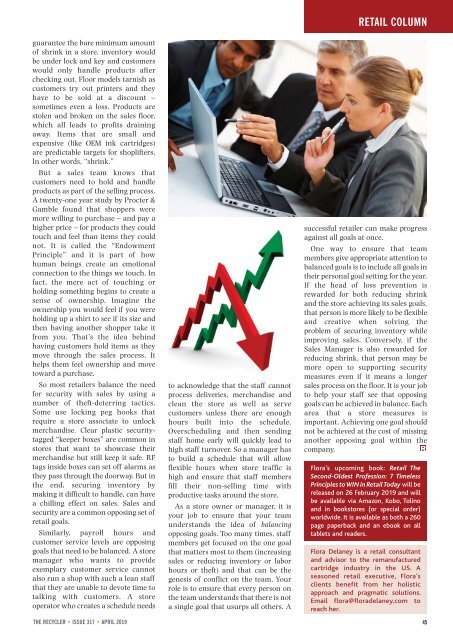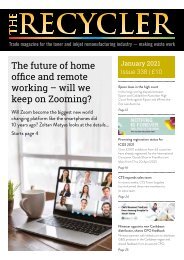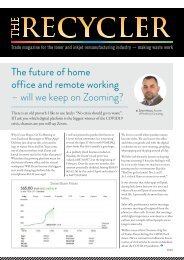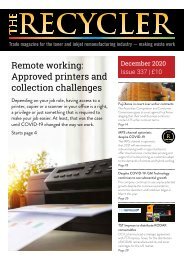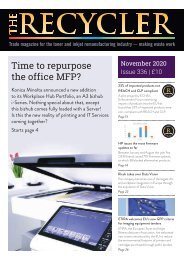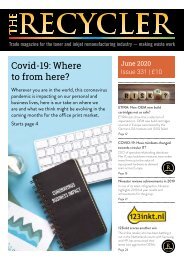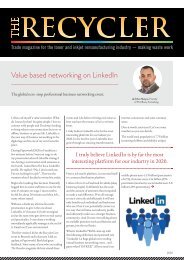The Recycler Issue 317
You also want an ePaper? Increase the reach of your titles
YUMPU automatically turns print PDFs into web optimized ePapers that Google loves.
guarantee the bare minimum amount<br />
of shrink in a store, inventory would<br />
be under lock and key and customers<br />
would only handle products after<br />
checking out. Floor models tarnish as<br />
customers try out printers and they<br />
have to be sold at a discount –<br />
sometimes even a loss. Products are<br />
stolen and broken on the sales floor,<br />
which all leads to profits draining<br />
away. Items that are small and<br />
expensive (like OEM ink cartridges)<br />
are predictable targets for shoplifters.<br />
In other words, “shrink.”<br />
But a sales team knows that<br />
customers need to hold and handle<br />
products as part of the selling process.<br />
A twenty-one year study by Procter &<br />
Gamble found that shoppers were<br />
more willing to purchase – and pay a<br />
higher price – for products they could<br />
touch and feel than items they could<br />
not. It is called the “Endowment<br />
Principle” and it is part of how<br />
human beings create an emotional<br />
connection to the things we touch. In<br />
fact, the mere act of touching or<br />
holding something begins to create a<br />
sense of ownership. Imagine the<br />
ownership you would feel if you were<br />
holding up a shirt to see if its size and<br />
then having another shopper take it<br />
from you. That’s the idea behind<br />
having customers hold items as they<br />
move through the sales process. It<br />
helps them feel ownership and move<br />
toward a purchase.<br />
So most retailers balance the need<br />
for security with sales by using a<br />
number of theft-deterring tactics.<br />
Some use locking peg hooks that<br />
require a store associate to unlock<br />
merchandise. Clear plastic securitytagged<br />
“keeper boxes” are common in<br />
stores that want to showcase their<br />
merchandise but still keep it safe. RF<br />
tags inside boxes can set off alarms as<br />
they pass through the doorway. But in<br />
the end, securing inventory by<br />
making it difficult to handle, can have<br />
a chilling effect on sales. Sales and<br />
security are a common opposing set of<br />
retail goals.<br />
Similarly, payroll hours and<br />
customer service levels are opposing<br />
goals that need to be balanced. A store<br />
manager who wants to provide<br />
exemplary customer service cannot<br />
also run a shop with such a lean staff<br />
that they are unable to devote time to<br />
talking with customers. A store<br />
operator who creates a schedule needs<br />
THE RECYCLER • ISSUE <strong>317</strong> • APRIL 2019<br />
to acknowledge that the staff cannot<br />
process deliveries, merchandise and<br />
clean the store as well as serve<br />
customers unless there are enough<br />
hours built into the schedule.<br />
Overscheduling and then sending<br />
staff home early will quickly lead to<br />
high staff turnover. So a manager has<br />
to build a schedule that will allow<br />
flexible hours when store traffic is<br />
high and ensure that staff members<br />
fill their non-selling time with<br />
productive tasks around the store.<br />
As a store owner or manager, it is<br />
your job to ensure that your team<br />
understands the idea of balancing<br />
opposing goals. Too many times, staff<br />
members get focused on the one goal<br />
that matters most to them (increasing<br />
sales or reducing inventory or labor<br />
hours or theft) and that can be the<br />
genesis of conflict on the team. Your<br />
role is to ensure that every person on<br />
the team understands that there is not<br />
a single goal that usurps all others. A<br />
RETAIL COLUMN<br />
successful retailer can make progress<br />
against all goals at once.<br />
One way to ensure that team<br />
members give appropriate attention to<br />
balanced goals is to include all goals in<br />
their personal goal setting for the year.<br />
If the head of loss prevention is<br />
rewarded for both reducing shrink<br />
and the store achieving its sales goals,<br />
that person is more likely to be flexible<br />
and creative when solving the<br />
problem of securing inventory while<br />
improving sales. Conversely, if the<br />
Sales Manager is also rewarded for<br />
reducing shrink, that person may be<br />
more open to supporting security<br />
measures even if it means a longer<br />
sales process on the floor. It is your job<br />
to help your staff see that opposing<br />
goals can be achieved in balance. Each<br />
area that a store measures is<br />
important. Achieving one goal should<br />
not be achieved at the cost of missing<br />
another opposing goal within the<br />
company.<br />
R<br />
Flora’s upcoming book: Retail <strong>The</strong><br />
Second-Oldest Profession: 7 Timeless<br />
Principles to WIN in Retail Today will be<br />
released on 26 February 2019 and will<br />
be available via Amazon, Kobo, Tolino<br />
and in bookstores (or special order)<br />
worldwide. It is available as both a 260<br />
page paperback and an ebook on all<br />
tablets and readers.<br />
Flora Delaney is a retail consultant<br />
and advisor to the remanufactured<br />
cartridge industry in the US. A<br />
seasoned retail executive, Flora’s<br />
clients benefit from her holistic<br />
approach and pragmatic solutions.<br />
Email flora@floradelaney.com to<br />
reach her.<br />
45


